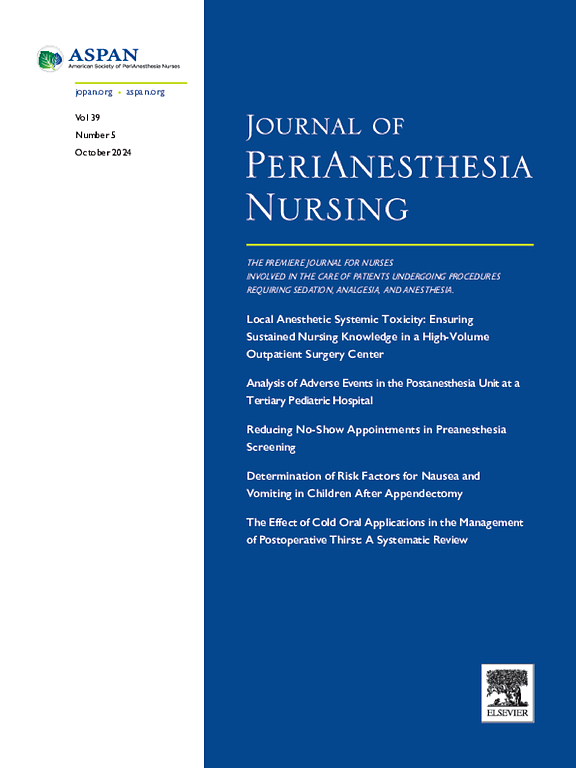不同剂量的罗哌卡因对接受上环包皮环切术的学龄儿童腹腔阻滞的影响
IF 1.6
4区 医学
Q2 NURSING
引用次数: 0
摘要
目的:本研究旨在评估三种不同剂量的罗哌卡因在学龄儿童尚环包皮环切术中的效果:这是一项前瞻性、随机对照研究:方法:共招募了 148 名美国麻醉学会 I 至 II 级儿童,并随机分配到 R0.2%、R0.25% 和 R0.3% 组。这些组别分别使用 0.2%、0.25% 和 0.3% 的罗哌卡因(0.5 mL/kg)进行尾椎阻滞。收集了围手术期的麻醉质量(包括充分镇痛率、镇痛持续时间、下肢麻木持续时间和术后首次排尿时间)和不良反应数据。围手术期还测量了血流动力学变量:R0.2%组的尾椎阻滞充分镇痛率(75.5%)明显低于R0.25%组(94.0%)和R0.3%组(98.0%)(P = .001)。R0.2% 组和 R0.25% 组的镇痛持续时间明显少于 R0.3% 组(P .05):结论:使用 0.3% 罗哌卡因进行臀部阻滞可为接受尚环包皮环切术的学龄儿童提供更令人满意的术中镇痛质量,同时不会增加不良反应的风险。本文章由计算机程序翻译,如有差异,请以英文原文为准。
The Effect of Different Doses of Ropivacaine for Caudal Block in School-aged Children Undergoing Shang Ring Circumcision
Purpose
The present study aimed to evaluate the effects of three different doses of ropivacaine in Shang Ring circumcision in school-aged children.
Design
This is a prospective, randomized, controlled study.
Methods
A total of 148 American Society of Anesthesiologists I to II children were enrolled and randomly assigned into the R0.2%, R0.25%, and R0.3% groups. These groups received 0.2%, 0.25%, and 0.3% of ropivacaine (0.5 mL/kg) for caudal block, respectively. The perioperative data on anesthesia quality (including adequate analgesia rate, analgesic duration, lower extremity numbness duration, and postoperative first urination time), and adverse events were collected. Hemodynamic variables were also measured perioperatively.
Findings
The adequate analgesia rate of caudal block in the R0.2% group (75.5%) was significantly lower than that in the R0.25% (94.0%) and R0.3% groups (98.0%) (P = .001). The analgesic duration of the R0.2% and R0.25% groups was significantly less than that of the R0.3% group (P < .001). The duration of lower extremity numbness in R0.2% group was significantly shorter than that in R0.25% (P < .05) and R0.3% groups (P < .01), and there was no significant difference between the R0.25% and R0.3% groups. The first urination time of R0.2% was significantly shorter than the R0.3% group (P < .05). There was no significant difference between the R0.2% and R0.25% or the R0.25% and R0.3% groups. No significant difference was found in adverse effects among groups (P > .05).
Conclusions
Caudal block with 0.3% ropivacaine can provide more satisfactory intraoperative analgesia quality for school-aged children receiving Shang Ring circumcision, without increasing the risk of adverse effects.
求助全文
通过发布文献求助,成功后即可免费获取论文全文。
去求助
来源期刊

Journal of Perianesthesia Nursing
NURSING-
CiteScore
2.20
自引率
17.60%
发文量
279
审稿时长
90 days
期刊介绍:
The Journal of PeriAnesthesia Nursing provides original, peer-reviewed research for a primary audience that includes nurses in perianesthesia settings, including ambulatory surgery, preadmission testing, postanesthesia care (Phases I and II), extended observation, and pain management. The Journal provides a forum for sharing professional knowledge and experience relating to management, ethics, legislation, research, and other aspects of perianesthesia nursing.
 求助内容:
求助内容: 应助结果提醒方式:
应助结果提醒方式:


